|
Great Moments in New Jersey Football History
November 12, 1898 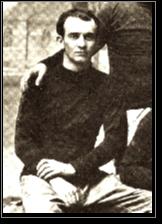
Sleek, speedy fair-haired Arthur Poe (right) was the personification of an 1890s college football hero. Though often the lightest man on the field and often hobbled by injury, he had a knack for making big plays when Princeton needed them most. In the Tigers’ 1898 meeting with national powerhouse Yale at Brokaw Field, Poe made perhaps the most famous play in school history. The Elis were attacking the Princeton goal line with a line plunge through a pile of more than a dozen bodies. Poe, standing just outside the pile-up, saw what some say was the Yale ball carrier turn to pitch the ball back to a teammate. Others say the ball just squirted out of the scrum. Whatever the case, Poe plucked the ball out of the air and turned upfield with three Yale players in hot pursuit. Normally Princeton’s fastest runner, he was limping badly (the newspapers described it as “skipping”) all the way. Poe was still fast enough to reach the end zone 95 yards away. He was hit by a Yale player after crossing the goal line, and then disappeared under a pile of celebrating students 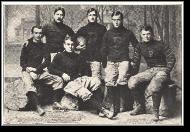 and teammates. The touchdown was worth 4 points. After the field was cleared, a two-point conversion was added to make the score 6–0. That is how the day ended. Incredibly, Poe repeated almost the same play in the second half. He scooped up a fumble and hobbled 90 yards for a touchdown. However, the ball was ruled dead at the spot he’d recovered it. Poe, a junior, mad Walter Camp’s second All-America team that season. In 1899, he was a first-team All-American. Poe was one of six football-playing brothers (left). And yes, they were related to Edgar Allan Poe. and teammates. The touchdown was worth 4 points. After the field was cleared, a two-point conversion was added to make the score 6–0. That is how the day ended. Incredibly, Poe repeated almost the same play in the second half. He scooped up a fumble and hobbled 90 yards for a touchdown. However, the ball was ruled dead at the spot he’d recovered it. Poe, a junior, mad Walter Camp’s second All-America team that season. In 1899, he was a first-team All-American. Poe was one of six football-playing brothers (left). And yes, they were related to Edgar Allan Poe.
December 25, 1961
Rutgers football had may high points in its first century of football, but only one undefeated season, 1961. The Scarlet Knights were 8–0 heading into their season finale at home against Columbia. The Lions had a good team that, in fact, had already secured a share of the Ivy League championship for the first time—and would later be enshrined in Columbia’s Ha; of Fame. Of Rutgers’ 8 prior victories, only the season opener had been close: a 16–13 road win at Princeton. 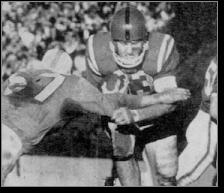 In the game against Columbia, the Scarlet Knights trailed 19–7 at the end of three quarters. Lee Curley caught a TD pass to narrow the gap to 6, but Rutgers missed the two-point conversion on a fake extra point kick. An interception by Pierce Frauenheim set up a quarterback sneak by Bill Speranza that tied the score, but Rutgers missed the point after. A long drive on the Knights’ next possession concluded with a short scoring run by All-American Steve Simms (left). In the closing minutes Rutgers tacked on another score when Fruaenheim picked off another pass and ran it in from 30 yards. The final score was 32–19. In the locker room after the game, Rutgers president Mason Gross congratulated coach John Bateman and said “This is the great team, the greatest season and the greatest coach that any college ever had.” In the game against Columbia, the Scarlet Knights trailed 19–7 at the end of three quarters. Lee Curley caught a TD pass to narrow the gap to 6, but Rutgers missed the two-point conversion on a fake extra point kick. An interception by Pierce Frauenheim set up a quarterback sneak by Bill Speranza that tied the score, but Rutgers missed the point after. A long drive on the Knights’ next possession concluded with a short scoring run by All-American Steve Simms (left). In the closing minutes Rutgers tacked on another score when Fruaenheim picked off another pass and ran it in from 30 yards. The final score was 32–19. In the locker room after the game, Rutgers president Mason Gross congratulated coach John Bateman and said “This is the great team, the greatest season and the greatest coach that any college ever had.”
 December 12, 1962 December 12, 1962
In 1962, the Atlantic Coast Football League played its inaugural season as a quasi-minor-league farm system for NFL clubs. The Franklin Miners, an independent semipro team from northern New Jersey, relocated to Paterson and played their home games at Hinchliffe Stadium. Sal Rosen coached the team to an 8–1 record, tying the Providence Steamroller—a club with deep roots in the pioneer days of pro football—for the league’s best record. The ACFL championship game was scheduled for Conventional Hall in Atlantic City. It was billed as the first pro football championship played indoors and, in a way, it was. Madison Square Garden had hosted World Championship tournaments in the early 1900s, and the Bears had hosted a de facto NFL title game in 1932 against the Portsmouth Spartans (later to become the Detroit Lions) after a snowstorm made their tiebreaking playoff contest untenable.
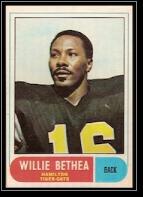 The Miners’ sole defeat came in their home opener against Providence—a 42–7 humiliation in front of 6,000 fans. The loss had a dulling effect on future attendance as the team drew only 1,000–2,000 for the rest of its games in New Jersey. There were few recognizable names on the Paterson roster, and several players had never played college ball (though several had played in the service). One of these men, halfback Willie Bethea (left), was a fantastic two-way player who was named MVP of the league. He would go on to star for the Hamilton Tiger Cats in the CFL. The team’s passing duties were shared by grizzled veteran Bill Baker and kicker-quarterback Neal Buckman, who had been a good player at the University of Alabama and was credited with 40 touchdown passes the previous year for Franklin. Paterson’s offensive line was led by tackle Stonewall Jackson, who played for Florida A&M after starring for Eastside High in Paterson. The defense was anchored by the Gunderman brothers, Bob and Tom, from Sparta. Both had starred in the ACC and Tom would go on to win ACFL MVP honors the following year. The Miners’ sole defeat came in their home opener against Providence—a 42–7 humiliation in front of 6,000 fans. The loss had a dulling effect on future attendance as the team drew only 1,000–2,000 for the rest of its games in New Jersey. There were few recognizable names on the Paterson roster, and several players had never played college ball (though several had played in the service). One of these men, halfback Willie Bethea (left), was a fantastic two-way player who was named MVP of the league. He would go on to star for the Hamilton Tiger Cats in the CFL. The team’s passing duties were shared by grizzled veteran Bill Baker and kicker-quarterback Neal Buckman, who had been a good player at the University of Alabama and was credited with 40 touchdown passes the previous year for Franklin. Paterson’s offensive line was led by tackle Stonewall Jackson, who played for Florida A&M after starring for Eastside High in Paterson. The defense was anchored by the Gunderman brothers, Bob and Tom, from Sparta. Both had starred in the ACC and Tom would go on to win ACFL MVP honors the following year.
Paterson opened the scoring in the second quarter when defensive end Cros Copeland, a star in college for Grambling, picked up a fumble on the Providence 25 and scampered into the end zone. The Steamroller tied the score in the third quarter but minutes later Paterson regained the lead on a TD pass from Baker to Rufus Chatman. Providence tied the game on a fourth-quarter TD pass and the two teams went into overtime knotted 14–14. Providence had the best scoring chance in the first 15-minute overtime after Jimmy Buonocore—who made several big defensive plays during regulation—returned a punt 27 yards deep into Paterson territory. But the Steamroller couldn’t capitalize after Bob Kessler missed a 37-yard field goal. The game finally ended near the conclusion of the second OT, when Paterson blocked a Steamroller punt. Buckman came on and split the uprights from 33 yards away to win 17–14 in front of a modest crowd of 2,000. The following year, the Miners moved their home field to Newark Schools Stadium and became the Newark Bears, borrowing a team name with a little history behind it.
December 19, 1981 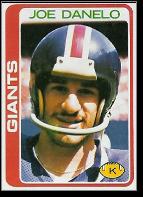
When the Cowboys came to the Meadowlands for the final game of the 1981 season, the Giants had a chance to do something they hadn’t done in 18 seasons: make the playoffs. It was a cold, windy day at Giants Stadium, producing a defensive battle that played to the club’s lone advantage. After a scoreless first half, the Giants broke the ice on a Scott Brunner TD pass. Brunner had taken over from young Phil Simms after Simms suffered an injury in Week 11. The Cowboys responded with 10 points in the 4th quarter to take the lead, and looked to run out the clock as the two-minute warning approached. But Tony Dorsett bobbled a pitch-out and George Martin recovered on the Giants’ 45. Moments later, Joe Danelo (right)—who had missed two field goals and almost blew an extra point—used the wind to his advantage and hooked a 40-yarder between the posts to tie the game. In overtime, Dorsett fumbled again, leading to a 33-yard attempt by Danelo. Who split he uprights to win the game.
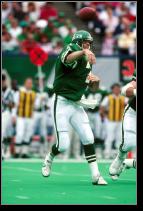 September 21, 1986 September 21, 1986
The Jets and Dolphins played some epic games during the Dan Marino era and this was the highest-scoring of them all. Marino threw for 448 yards and a career-best 6 touchdowns, while Ken O’Brien (left) completed 29 of 43 passes for 479 yards and five scores, including four to Wesley Walker. Miami held a 45–38 lead late in the 4th quarter when O’Brien and Walker connected on a 21-yard TD pass with no time on the clock to force overtime. Two minutes and 35 seconds into the extra period, the two reconnected on a 43-yarded to win the game, 51–45. Walker had nearly worn the game’s goat horns—in the 4th quarter he fumbled on his own 27, leading to the Dolphins’ go-ahead score.
October 23, 2000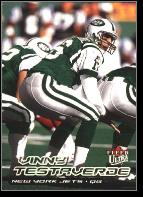
The Jets trailed Miami 30–7 in the fourth quarter of a Monday Night Football game, only to tie the score and win by a field goal in overtime. The game, which has since been immortalized as The Monday Night Miracle, saw Gang Green tie the score twice in the final moments. After knotting the score 30–30, Jets fans watched in horror as Jay Fielder hit Leslie Shepherd on a 46-yard TD pass. Vinny Testaverde (right) drove the Jets back down the field, and tied the game on a tackle-eligible play to lineman Jumbo Elliott. It was the third TD scored that quarter by a Jet who had never caught a scoring pass. The fourth-quarter comeback was the largest in league history. John Hall won the game 40–37 midway through the overtime period with a 40-yard field goal.
January 14, 2001
Despite hosting the Minnesota Vikings in the NFC Championship Game, the Giants entered the contest as a 2-point underdog. The Viking offense was a juggernaut that had to be kept off the field. Offensive coordinator Sean Payton detected a weakness in Minnesota’s secondary and drew up a gameplan to exploit it. Two minutes into the game, Kerry Collins hit Ike Hilliard with a TD 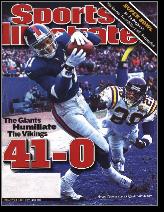 pass. After the Vikings fumbled the ensuing kickoff, Collins spotted blocking back Greg Comella open in the end zone and drilled a pass that Comella caught in self-defense to give Big Blue a 14–0 lead. Daunte Culpepper looked to get his team back in the game, hitting Cris Carter with a perfect pass in the end zone. But Emmanuel McDaniel ripped it out of Carter’s hands for an interception. The Vikings never recovered, and Bog Blue poured it on to win 41–0. It was the second-most lopsided shutout in NFL postseason history. Collins executed Payton’s plan to perfection, torching the secondary for 381 yards and 5 touchdowns. The Giants amassed 404 more total yards than the Vikings—the largest discrepancy in the history of the playoffs. The much-maligned Giants were on their way to the Super Bowl (which they lost) but owner Wellington Mara was determined to celebrate with the fans rught then and there. “This is the Giants team that was referred to as the worst ever to win home-field advantage in the National Football League,” he growled into the PA system. “Today, on this field of painted mud, we proved that we’re the worst team to ever win the National Football Conference championship.” pass. After the Vikings fumbled the ensuing kickoff, Collins spotted blocking back Greg Comella open in the end zone and drilled a pass that Comella caught in self-defense to give Big Blue a 14–0 lead. Daunte Culpepper looked to get his team back in the game, hitting Cris Carter with a perfect pass in the end zone. But Emmanuel McDaniel ripped it out of Carter’s hands for an interception. The Vikings never recovered, and Bog Blue poured it on to win 41–0. It was the second-most lopsided shutout in NFL postseason history. Collins executed Payton’s plan to perfection, torching the secondary for 381 yards and 5 touchdowns. The Giants amassed 404 more total yards than the Vikings—the largest discrepancy in the history of the playoffs. The much-maligned Giants were on their way to the Super Bowl (which they lost) but owner Wellington Mara was determined to celebrate with the fans rught then and there. “This is the Giants team that was referred to as the worst ever to win home-field advantage in the National Football League,” he growled into the PA system. “Today, on this field of painted mud, we proved that we’re the worst team to ever win the National Football Conference championship.”
January 4, 2003 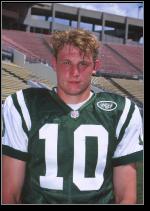
The Jets were playing with house money as the playoffs began. Given up for dead with 1 win in their first 5 games, they squeaked into the playoffs only to find themselves hosting Peyton Manning and the Colts. In the first playoff game to feature two African American head coaches (Tony Dungy and Herman Edwards), Jets QB Chad Pennington (right) ended up making all the headlines when he out-passed Manning and propelled New York to a 41–0 win. The game opened with a 56-yard TD catch and run by Richie Anderson on a screen pass. It set a team record for the longest postseason scoring play. Manning suffered from poor pass protection and a half-dozen drops. Meanwhile, Pennington’s three scoring passes tied Joe Namath’s team playoff record.
November 9, 2006
When Rutgers scheduled Louisville for a November game, no one in the world imagined that the Scarlet Knights would be 8–0 and climbing in the national rankings. Even so, when the #3-ranked Cardinals rolled into Piscataway, even the most ardent Rutgers fans secretly feared a blowout. Playing on national TV, the Scarlet Knights not only held their own, they played Louisville to a 25–25 standoff and had the ball with less than a minute left. Kicker Jeremy Ito had a chance to win the game, but missed a chip shot. Incredibly, a Cardinals player was off sides and Rutgers had another shot. This time Ito drilled the kick and set off utter pandemonium, as tens of thousands of fans and students flooded the field. The victory put the school on the football map. Literally. The previous year, at the Insight Bowl in Phoenix, the players were constantly being asked the same question: Where’s Rutgers?
|
|
|